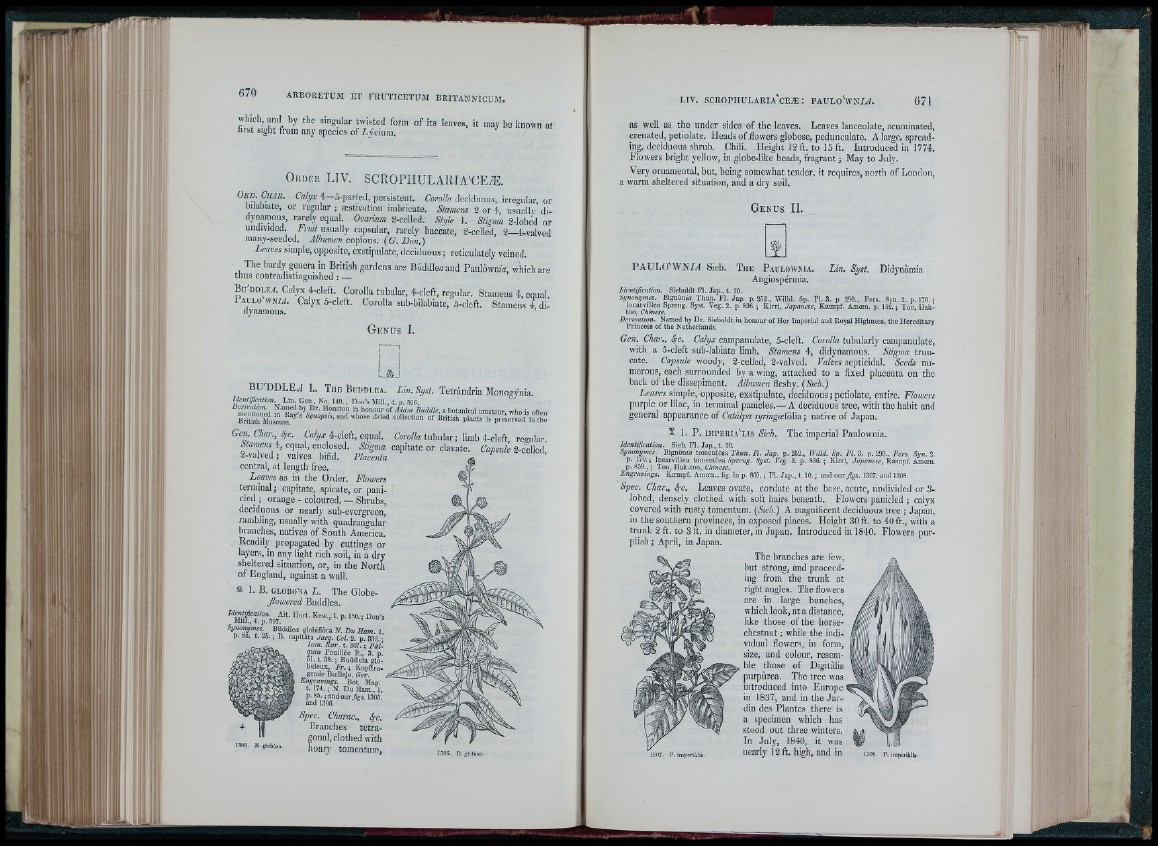
which, mu! by the singular twisted form of its leaves, it may be known at
first sight from any species of iycium.
O r d e r LIV. SCIIOPHULAHIA'CEÆ.
O rd . C h a r. Caiyx 4—5-parted, persistent. CoroIJa deciduous, irregular, or
bilabiate, or regular ; æstivation imbricate. Stamem 2 or 4, usuallv di-
dyi/mous, rarely equal. O m ™ 2-celled. S t y t e i . 2-lobed or
undivided Fnat usually capsular, rarely baccate, 2-celled, 2_4-valved
inany-seecled. Albumen copious. {G. Don.)
Leaves simple, opposite, exstipulate, deciduous ; reticulately veined.
The hardy genera in British gardens are Búddiea and Paulownia which are
thus contradistinguished ; —
Bu'ddle.4. Calyx /c le ft. Corolla tubular, 4-cleft, regular. Stamens 4, enual.
1 A/ . 0 WNM. Calyx 5-cleft. Corolla sub-bilabiate, 5-cleft. Stamens 4 di-
dynamous. ’
G e n u s 1 .
BU DDLErt L. The Buudi.ea. Lin. Syst. Tetrândria Monogynia.
Uenlipeation. Lin. Gen , No. 140. ; Don's Mill., 4, p. 596.
m rat m en “f Budile, a botanical amateur, tvho is often
B r i f r t Museum. and whose dried eollection of British plants Is preserved in the
Gen. Char. 4e. Co/t/o-4-cIeft, equal. CVo//a tubular; limb 4-cleft, regular
Siamcns 4, equal, enclosed. Stigma capitate or clavate. Cayjsa/e 2-celled,
2-valved ; valves bifid. Placenta
central, at length free.
Leaves as in the Order. Flowers
terminal ; capitate, spicate, or panicled
; orange - coloured. — Shrubs,
deciduous or nearly sub-evergreen,
rambling, usually with quadrangular
branches, natives of South America.
Readily propagated by cuttings or
layers, in any light rich soil, in a dry
sheltered situation, or, in tlie North
of England, against a wall.
3É 1. B. GLOBO'SA L. The Globe-
flowered Buddlea.
'• P- fr“"'*
S m o n jm e s . Büddleo^lobiüôra N. D» 1,
B. capitàta Ju
Jacq. Col. 2. p. 332. ;
on.Rar.t. 307.; Pài-
1305, B. globósa
Icon. ....... . j J,
quin Feuillée It., 3. p.
51. t.3 8 .; Buddleia globuleux,
Fr. ; Kopftra-
geude Budleje, Ger.
Engravings. Bot. Mag.
t. 174. ; N. Du Ham., I.
p. 86. ; and o u r/g s . 1305.
and 1306.
Spec, Charac., 4i>
Branches tetragonal,
clothed with
hoary tomentum, 5. B. globósa.
671
as well as the under sides of theleaves. Leaves lanceolate, acuminated,
crenated, petiolate. Heads of flowers globose, pedunculate. Alarge, spreading,
deciduous shrub. Chili. Height 12 ft. to 15 ft. Introduced in 1774.
Flov/ers bright yellow, in globe-like heads, fragrant; May to July.
Very ornamental, but, being somewhat tender, it requires, north of London,
a warm sheltered situation, and a dry soil.
G e n u s I L
PAULO'WN/.?! Sieb. T h e P a u l o w n i a .
Angiospérmia.
Sieboldt Fl. Jap., t. 10.
Lin. Syst. Didynàmia
Identification. ............. ........
Synonymes. Bignònja Thun. Fl. Jap. p. 2.52., Willd. Sp. PI. 3. p. 290., Pers. Syn. 2. p. 170. ;
Incar villea Spreng. Syst. Veg. 2. p. 836. ; Kirri, Japanese, Kæmpf. Amoen. p. 152. ; Too. Uak-
too, Chmese.
Derivation. Named by Dr. Sieboldt in honour of Her Imperial and Royal Highness, the Hereditary
Princess of the Netherlands. j e . 3
Gen. Char,, 4’C. Calyx campanulate, 5-cleft. Corolla tubularly campanulate,
with a 5-cleft sub-labiate limb. Stamens 4, didynamous. Stigma truncate.
Capsule woody, 2-celled, 2-valved. Valves septicidal. Seeds numerous,
each surrounded by a wing, attached to a fixed placenta on the
back of the dissepiment. Albumen fleshy. {Sieb.)
Leaves simple, opposite, exstipulate, deciduous; petiolate, entire. Flowers
purple or lilac, in terminal panicles.— A deciduous tree, with the habit and
general appearance of Catalpa syringæiolia ; native of Japan.
¥ 1. P. im p e r i a ' l i s Sieb. The imperial Paulownia.
Identification. Sieb. F l. Jap., t. 10.
Synonymes. Bignònìo tomentósa Thun. Fl. Jap. p. 252., Wtlld. Sp. PL 3. p. 290., Pers. Syn. 2.
p- 170. ; Incarvillefl tomentiisa Spreng. Syst. Veg. 2. p. 836. ; Kirri, Japanese, Kæmpf. Amoen.
p. 859., ; Too, Hak-too, Chinese.
Engruvings. Kæmpf. Amoen., fig. in p. 860. ; Fl. Jap., t. 10. ; and oar figs. 1307. and 1308.
Spec. Char., 4'C. Leaves ovate, cordate at the base, acute, undivided or 3-
lobed, densely clothed with soft hairs beneath. Flowers panicled ; calyx
covered with rusty tomentum. {Sieb.) A magnificent deciduous tree ; Japan,
in the southern provinces, in exposed places. Height 30 ft. to 40 ft., with a
trunk 2 ft. to 3 it. in diameter, in Japan. Introduced in 1840. Flowers purplish
; April, in Japan.
The branches are few,
but strong, and proceeding
from the trunk at
right angles. The flowers
are in large bunches,
which look, at a distance,
like those o fth e horse-
chestnut ; while the individual
flowers, in form,
size, and colour, resemble
those of Digitalis
purpurea. The tree was
introduced into Europe *
in 1837, and in the Jardin
des Plantes there is
a specimen which has
stood out three winters.
In July, 1840, it was
nearly 12 ft. high, and in isos. p. impeiikiu